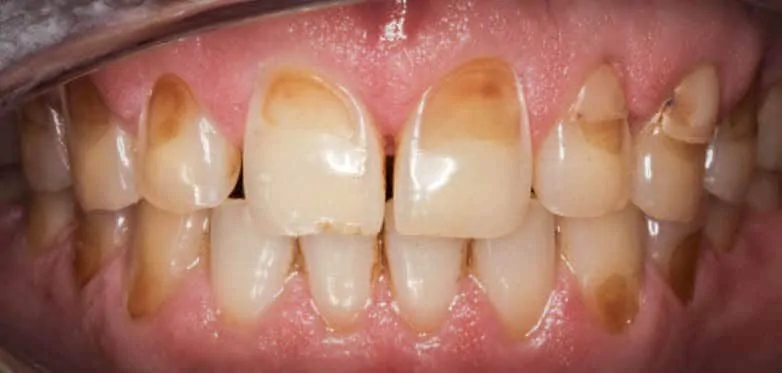
The correct toothbrushing technique is essential to ensure the maximum amount of build-up is thoroughly removed, thus ensuring better gum and dental health.
Firstly, it is important to use a soft-bristled brush. A hard toothbrush does not brush any better, and will likely cause damage to both your gums and teeth, by causing gum recession and abrasion cavities, both of which will result in very sensitive teeth. Also, choosing a compact head allows the toothbrush to reach difficult-to-access areas in the mouth.
Always use a soft or extra-soft toothbrush. Never use a medium or hard toothbrush.

Some examples of recommended toothbrushes

Soft, tapered bristles are best

Abrasion cavities and gum recession caused by overzealous tooth brushing, especially with a medium or hard toothbrush! These areas will be very sensitive, and will need fillings to treat the sensitivity.
Secondly, it is important to have the bristles come into light contact with your gums at a 45-degree angle in order to remove the maximum amount of plaque possible. Brushing your gums with excessive force is not advisable, as it will damage your gums, and avoiding your gums altogether while brushing your teeth will only allow the plaque to stay and mature and eventually harden along the gum margins. A gentle massage of the gums with a soft toothbrush is ideal and strikes the balance of cleaning your teeth without unnecessary damage.
If you experience bleeding gums when you brush, don’t panic, as it is a sign of gum inflammation. In fact, it is a sign that your gums are not clean and therefore need to be brushed thoroughly.
After a couple of days of proper brushing, the bleeding should subside as your gums get healthier. If it doesn’t, then it is time to schedule a Scaling & Polishing appointment in order to properly debride your gums to remove the offending irritants.
Thirdly, it is highly recommended that you brush at least twice a day, for 2 to 5 minutes each time, in order to ensure proper and thorough brushing. At night, it is best to avoid eating after brushing or else you will be sleeping with food particles in your mouth!
BRUSHING GUIDE
- Place the soft toothbrush at a 45-degree over your teeth and gums.
- Move the toothbrush in a small circular motion over the inner and outer surfaces of your teeth.
- Avoid long, horizontal scrubbing strokes along the inner and outer surfaces of teeth as this will cause damage to your teeth and gums.
- Scrubbing is only recommended for grinding or biting surfaces, never near the gums.
- Tip the toothbrush such that the head of the toothbrush is touching the inner surfaces of your front teeth and the back surfaces of the last teeth and brush outwards.
Should I Brush My Teeth Right After Eating?
Brushing right after your meals is actually a bad idea, as your teeth are in a “softened” state and you will end up wearing down the enamel more. Any form of foods introduced into the oral cavity, especially those containing carbohydrates and sugars, including staple foods such as rice, bread, pasta, noodles, will be broken down by the bacteria present on your teeth into acids, which will in turn lower the pH in the oral cavity and make your teeth more vulnerable to toothbrush wear.

Stephan Curve – a graph showing the drop in pH after eating or drinking, which falls below the critical pH where enamel is in a “softened state” and takes longer time to recover to normal pH levels
This graph above shows the Stephan Curve, a well-researched and well-recorded phenomenon where the pH of the oral cavity drops quickly after a meal, below the critical pH, which is the pH the enamel starts dissolving and loses the minerals (demineralisation). The pH will then slowly rise again back to a more normal pH and the minerals are added back into the enamel (remineralisation), thanks to the action of our saliva, but the time taken is much slower. By referring to this graph, it is thus recommended to wait at least 30 minutes after eating and/or drinking before brushing your teeth, to reduce wear and erosion on your teeth.
Do not brush immediately after eating! You should wait at least 30 minutes before brushing your teeth.

Teeth with worn down enamel, exposing the yellow dentine layer
That being said, brushing alone is not enough! Click here to read more about flossing and its importance.



